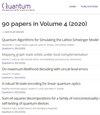Simulating Meson Scattering on Spin Quantum Simulators
IF 5.1
2区 物理与天体物理
Q1 PHYSICS, MULTIDISCIPLINARY
引用次数: 0
Abstract
Studying high-energy collisions of composite particles, such as hadrons and nuclei, is an outstanding goal for quantum simulators. However, preparation of hadronic wave packets has posed a significant challenge, due to the complexity of hadrons and the precise structure of wave packets. This has limited demonstrations of hadron scattering on quantum simulators to date. Observations of confinement and composite excitations in quantum spin systems have opened up the possibility to explore scattering dynamics in spin models. In this article, we develop two methods to create entangled spin states corresponding to wave packets of composite particles in analog quantum simulators of Ising spin Hamiltonians. One wave-packet preparation method uses the blockade effect enabled by beyond-nearest-neighbor Ising spin interactions. The other method utilizes a quantum-bus-mediated exchange, such as the native spin-phonon coupling in trapped-ion arrays. With a focus on trapped-ion simulators, we numerically benchmark both methods and show that high-fidelity wave packets can be achieved in near-term experiments. We numerically study scattering of wave packets for experimentally realizable parameters in the Ising model and find inelastic-scattering regimes, corresponding to particle production in the scattering event, with prominent and distinct experimental signals. Our proposal, therefore, demonstrates the potential of observing inelastic scattering in near-term quantum simulators.自旋量子模拟器上介子散射模拟
研究复合粒子(如强子和原子核)的高能碰撞,是量子模拟器的一个突出目标。然而,由于强子的复杂性和波包的精确结构,强子波包的制备面临着巨大的挑战。这限制了迄今为止在量子模拟器上对强子散射的演示。量子自旋系统中约束和复合激发的观测为探索自旋模型中的散射动力学提供了可能性。在本文中,我们开发了两种方法来创建与伊辛自旋哈密顿量模拟量子模拟器中复合粒子的波包相对应的纠缠自旋态。一种波包制备方法利用了超近邻伊辛自旋相互作用的封锁效应。另一种方法利用量子总线介导的交换,例如捕获离子阵列中的自旋声子耦合。以捕获离子模拟器为重点,我们对这两种方法进行了数值基准测试,并表明在近期实验中可以实现高保真波包。我们对Ising模型中实验可实现参数的波包散射进行了数值研究,发现与散射事件中粒子产生相对应的非弹性散射区具有明显的实验信号。因此,我们的提议证明了在近期量子模拟器中观察非弹性散射的潜力。
本文章由计算机程序翻译,如有差异,请以英文原文为准。
求助全文
约1分钟内获得全文
求助全文
来源期刊

Quantum
Physics and Astronomy-Physics and Astronomy (miscellaneous)
CiteScore
9.20
自引率
10.90%
发文量
241
审稿时长
16 weeks
期刊介绍:
Quantum is an open-access peer-reviewed journal for quantum science and related fields. Quantum is non-profit and community-run: an effort by researchers and for researchers to make science more open and publishing more transparent and efficient.
 求助内容:
求助内容: 应助结果提醒方式:
应助结果提醒方式:


